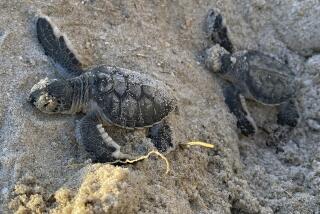Backpack & Budget : Nurturing Nature in Costa Rica
- Share via
Some of the most memorable moments I’ve experienced in a foreign country were during a moonlit night on a Costa Rican beach when I joined a small group to watch quietly as a giant leatherback turtle hauled herself up from the sea to dig a nest and, in a trance-like state, deposit her eggs.
The tiny Central American nation of Costa Rica is an environmentalist’s delight. About 5% of all known species on Earth can be found here and yet it covers less than three-ten thousandths of the world’s land area.
Independent travelers have a new source of current information to help them learn more about the fascinating flora and fauna of this Central American nation and to help them arrange their own explorations of the country. It’s the 574-page, first edition of “Costa Rica Handbook” (Moon Publications, $17.95) by Christopher Baker.
Within the compact nation is a diverse terrain that includes belching volcanoes, tropical rain forest and sandy surfing beaches. “About the only adventure activities not possible in Costa Rica are those that involve snow skis or camels,” Baker points out.
Budget travelers will find that they can reach most points within the country from San Jose by bus for under $6. One of the areas especially attractive to young North American travelers is Tamarindo on the Pacific Coast. It’s a popular surfing area with a range of accommodations from backpackers’ lodges to deluxe hotel rooms.
From Tamarindo, it’s a short trip to the beach with the turtles. In fact, evening turtle tours can be arranged at many Tamarindo hotels.
The nearby Playa Grande beach in Las Baulas Marine Turtle National Park is a key Pacific Coast nesting area for the giant leatherback turtle. The nesting period is October to April. Up to 70 of these giants (they can weigh up to more than 2,000 pounds) lug themselves up onto the beach over the course of a night to deposit their eggs.
Costa Rica protects a larger proportion of its land than any other country. This means protection for a diversity of creatures, ranging from the shy but powerful jaguar to 51 species of hummingbirds, from the mysterious manatee to vampire bats or howler monkeys.
Another popular stop for group and do-it-yourself ecotourists is Monteverde (the name means Green Mountain). The area was settled by 40 American Quakers in 1951 and has developed into the 25,935 acres Monteverde Biological Cloud Forest Preserve, home to more than 100 species of birds and over 1,200 species of amphibians and reptiles.
Although there are 30 lodges in the area, it is also possible for backpackers to arrange dormitory-style lodging at the visitor center for $5 per night ($15 with meals). Reservations are advised.
More to Read
Sign up for The Wild
We’ll help you find the best places to hike, bike and run, as well as the perfect silent spots for meditation and yoga.
You may occasionally receive promotional content from the Los Angeles Times.





